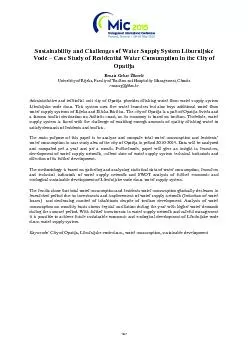

Vode 150 Case Study of Residential Water Consumption in the City of Opatija Renata Grbac 142ikoviUniversity of Rijeka Faculty of Tourism and Hospitality Management Croatia renatagfthmhr Admi ID: 849464
Download Pdf The PPT/PDF document "Vode Case Study of Residential Water Co..." is the property of its rightful owner. Permission is granted to download and print the materials on this web site for personal, non-commercial use only, and to display it on your personal computer provided you do not modify the materials and that you retain all copyright notices contained in the materials. By downloading content from our website, you accept the terms of this agreement.
1 Vode Case Study of Residential Water C
Vode Case Study of Residential Water Consumption in the City of Opatija Renata Grbac ikoviUniversity of Rijeka, Faculty of Tourism and Hospitality Management, Croatia renatag@fthm.hr Administrative and territorial unit city of Opatija provides drinking water from water supply system Liburnijske vode d.o.o. This system uses five water resources but also buys additional water from water supply systems of Rijeka and Ilirska Bistrica. The city of Opatija is a part of Opatija riviera and a famous tourist destination on Adriatic coast, so its economy is based on tourism. Therefore, water supply system is faced with the challenge of enabling enough amounts of quality drinking water to satisfy demands of residents and tourists. The main purpose of this paper is to analyze and compare total water consumption and residents water consumption in case study area of the city of Opatija in period 2010-2014. Data will be analyzed and compared per a year and per a month. Furthermore, paper will give an insight in resources, development of water supply network, current state of water supply system technical indicators and direction of its further development. The methodology is based on gathering and analyzing statistical data of water consumption, resources and technical indicators of water supply network and SWOT analysis of further economic and nijske vode d.o.o. water supply system. The results show that total water consumption and residents water consumption gradually decreases in researched period due to investments and improvement of water supply network (reduction of water losses) and decreasing number of inhabitants despite of tourism development. Analysis of water consumption on monthly basis shows regular oscillation during the year with higher water demands during the summer period. With further investments in water supply network and careful management it is possible to achieve future sustainable economic and ecological development of Liburnijske vode d.o.o. water supply system. City of Opatija, Liburnijske vode d.o.o., water consumption, sustainable development Vode – Case Study of Residential Water Consumption in the City of Opatija Renata Grbac ŽikoviUniversity of Rijeka, Faculty of Tourism and Hospitality Management, Croatia renatag@fthm.hr Administrative and territorial unit city of Opatija provides drinking water from water supply system Liburnijske vode d.o.o. This system uses five water resources but also buys additional water from water supply systems of Rijeka and Ilirska Bistrica. The city of Opatija is a part of Opatija riviera and a famous tourist destination on Adriatic coast, so its economy is based on tourism. Therefore, water supply system is faced with the challenge of enabling enough amounts of quality drinking water to satisfy demands of residents and tourists. The main purpose of this paper is to analyze and compare total water consumption and residents’ water consumption in case study area of the city of Opatija in period 2010-2014. Data will be analyzed and compared per a year and per a month. Furthermore, paper will give an insight in resources, development of water supply network, current state of water supply system technical indicators and direction of its further development. The methodology is based on gathering and analyzing statistical data of water consumption, resources and technical indicators of water supply network and SWOT analysis of further economic and nijske vode d.o.o. water supply system. The results show that total water consumption and residents water consumption gradually decreases in researched period due to investments and improvement of water supply network (reduction of water losses) and decreasing number of inhabitants despite of tourism development. Analysis of water consumption on monthly basis shows regular oscillation during the year with higher water demands during the summer period. With further investments in water supply network and careful management it is possible to achieve future sustainable economic and ecological development of Liburnijske vode d.o.o. water supply system. City of Opatija, Liburnijske vode d.o.o., water consumption, sustainable development